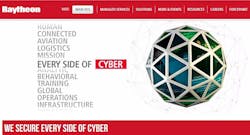Aviation, like all critical infrastructure, is connected and vulnerable, should be protected
PARIS AIR SHOW. Security should be top of mind for aviation professionals today, says David Ray, vice president, global business development and strategy, Raytheon Intelligence, Information and Services in Washington. “From iPhones to fighter jets, and from the aircraft supply chain to the entire aviation infrastructure, everything is connected – and therefore all vulnerable – as cyber attacks threaten this ecosystem with potential data loss, denial of service, or more.”
David Ray
Vice President, Global Business Development and Strategy
Raytheon Intelligence, Information and Services
Washington, D.C., USA
What are you excited to see at Paris Air Show (aircraft, technology, market segment)?
I am excited to see how the aerospace market is looking at the cybersecurity threat. Aviation, like all critical infrastructure that is connected, can be vulnerable to cyber threats. A few years ago, when we started talking about cybersecurity at airshows it seemed a little premature. However now with cybersecurity top of mind, it makes sense that this be a topic at the airshow.
In addition, with delegations coming from multiple countries, this is a great opportunity to share how cybersecurity can be deployed to protect all critical infrastructure, from aviation to financial to power utilities, hospitals, and more.
What are you excited to bring to/share at the show?
Our Cyber Center demonstration, which shows several different solutions that protect every side of cyber, including risk mitigation, threat intelligence, cyber defense, proactive threat hunting, and remediation.
The exhibit enables us to demonstrate Raytheon’s full-spectrum capabilities, decades of proven expertise and multi-layered approach to cyber solutions drive resiliency against complex challenges.
From iPhones to fighter jets, and from the aircraft supply chain to the entire aviation infrastructure, everything is connected – and therefore all vulnerable – as cyberattacks threaten this ecosystem with potential data loss, denial of service, or more.
What will your technology focus be at the show and immediately following it?
Cybersecurity and subsystems for the F-35 are areas of focus at the show this year. We offer the broadest set of capabilities in cybersecurity in the world. In addition we are featuring our new Joint Precision Approach and Landing Systems for the F-35, which enables the landing of fast jets and UAVs on carriers within 20 centimeters accuracy.
How would you sum up the current state of the aerospace industry (overall health, growth areas, current technology needs or focuses, future forecast)?
The state of the industry is positive with continued air travel growth and demand for innovation in both commercial and defense markets. As a defense, air traffic management, and cybersecurity leader, Raytheon is excited about the opportunities to meet with customers and partners at the Paris Air Show. We look forward to exploring opportunities to use innovative processes and technology to drive performance, efficiencies, and security to ensure a safer world.
Are you going into the show looking for feedback or info that will influence your product offerings or direction?
Yes, we are always looking for feedback from our customers on how we can better serve their goals and help them achieve mission success – events like the Paris Airshow are a great opportunity to get that direct feedback.
One specific technology where we are looking for customer insights is our Avionics Intrusion Detection system. It’s a company-funded R&D project to provide commercial and military pilots with a cyberattack warning system.
Raytheon has been investing in research and development towards an intrusion detection system for a standard avionics communications bus. Our prototype works on the back end to determine if there is anomalous activity taking place.
Our system will look for and detect unauthorized intrusions among traffic that crosses through the avionics bus — the communication system that controls, monitors and transfers data between different electronic components in the aircraft. Notifications will be pushed to the pilot display in the cockpit.
You can think of it as the cyber equivalent of an early warning system. The system is currently at TRL Level 4.
What’s the hottest trend you’re seeing? Any bleeding-edge technology or segment to watch?
Cybersecurity in Aerospace and Defense is the cutting edge segment to watch this year. Cyber touches everything we do in this increasingly connected world. Everything from the aviation infrastructure to cyber hardening defense systems such as UAVs, networks, and weapons systems. Raytheon is at the forefront of cybersecurity with the broadest set of capabilities in the world, from vulnerability research and assessments to cybersecurity on a national level.
What are the biggest challenges facing the aerospace community today? How do you see them being addressed?
Again, cybersecurity is really the biggest challenge facing the aerospace community, as well as just about every industry. Cyber threats are increasing and changing in both military and commercial markets potentially impacting anything that is connected. As a defense, air traffic management and cybersecurity leader, Raytheon provides solutions that address the confluence of all of these areas.
For example, during military operations, a cyberattack on an aircraft could result in aircrews unknowingly relying on manipulated data in their cockpits – from aircraft operations to navigation readings. On commercial flights, safety could be at risk or there could be an enormous economic impact if flight schedules are disrupted.
Particularly with legacy aircraft and systems. Many aircraft flying today were developed long before cyber threats were even a consideration.
These are just a couple of examples that illustrate the importance of making systems and platforms more cyber secure.
What does the rest of the year hold for you/the company? Any particular focus?
We have been and will continue to be focused on C5ISR. Raytheon IIS is a leader in battle management command and control and C5ISR. This is the backbone for the military’s intelligence. We provide C5ISR capabilities to give the warfighter an edge in the battle space with our specialty in analytics, automation, and cyber. And cyber is a big part of battle management command and control and a discriminator for Raytheon. With our expertise in automation, analytics and cyber, we are providing solutions that act as the Central Nervous System for many of our customers systems.


